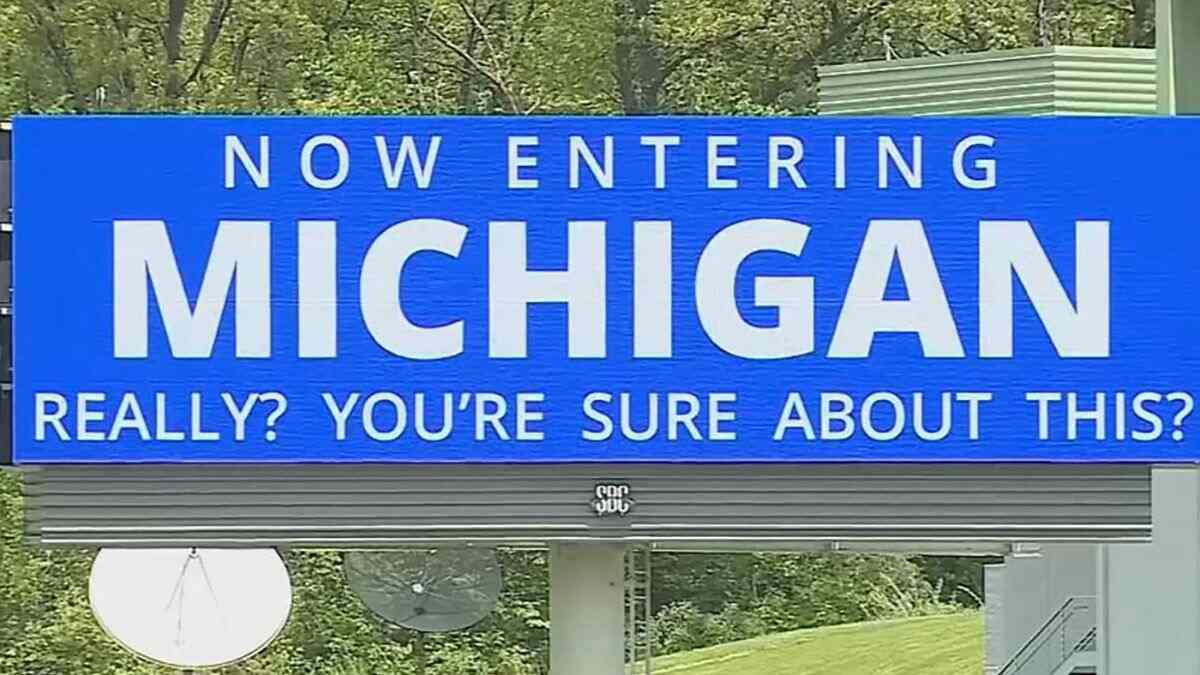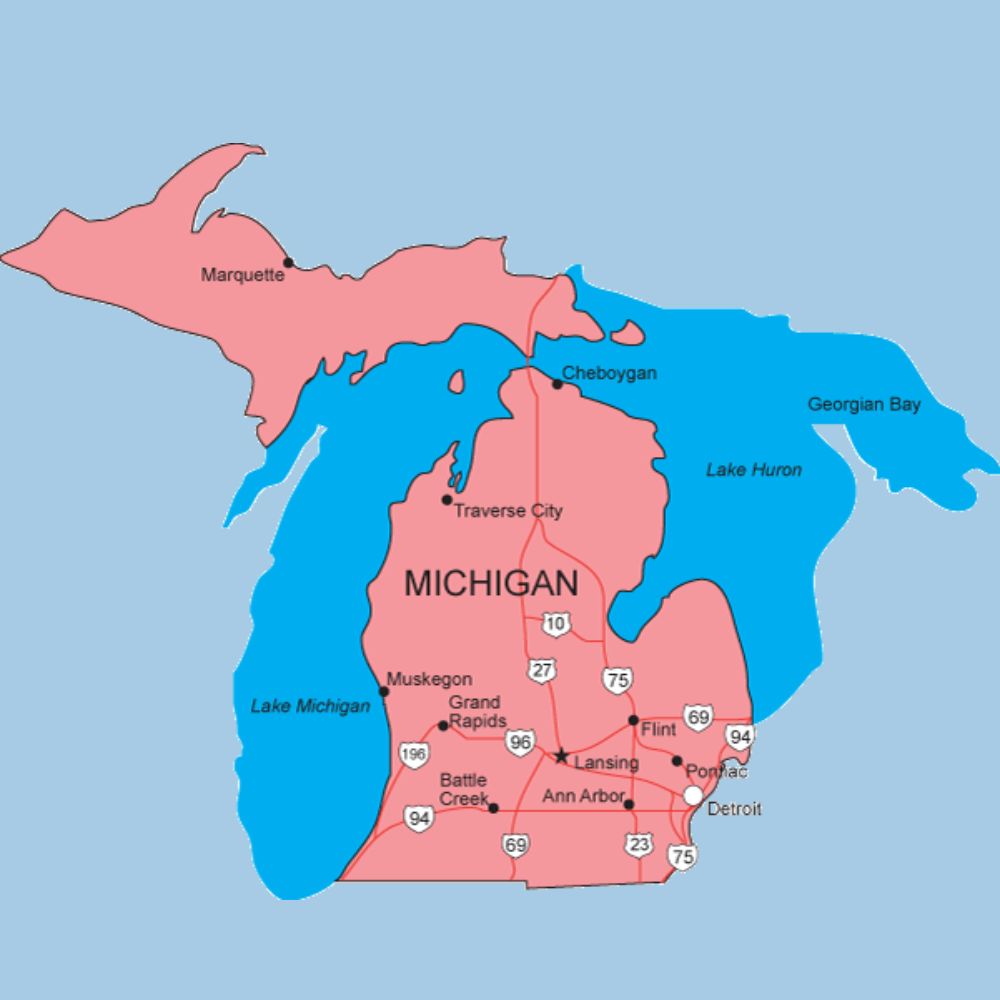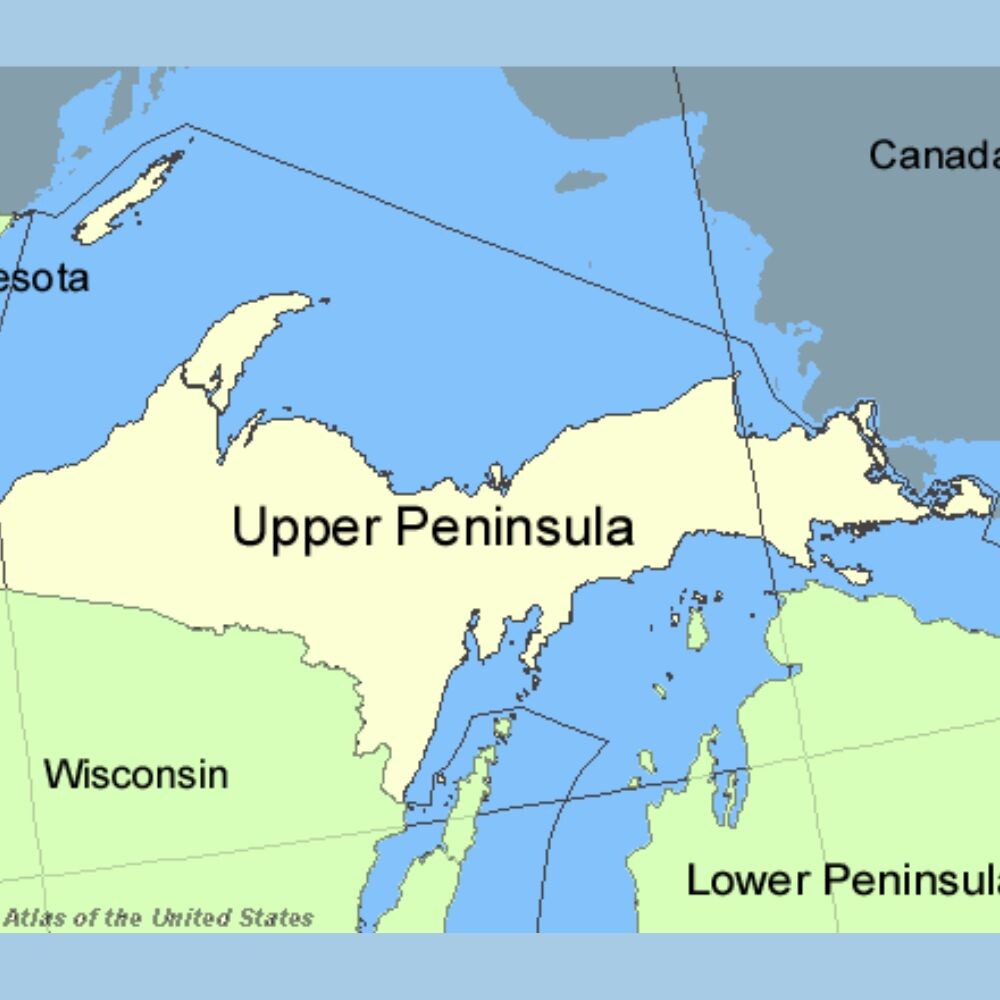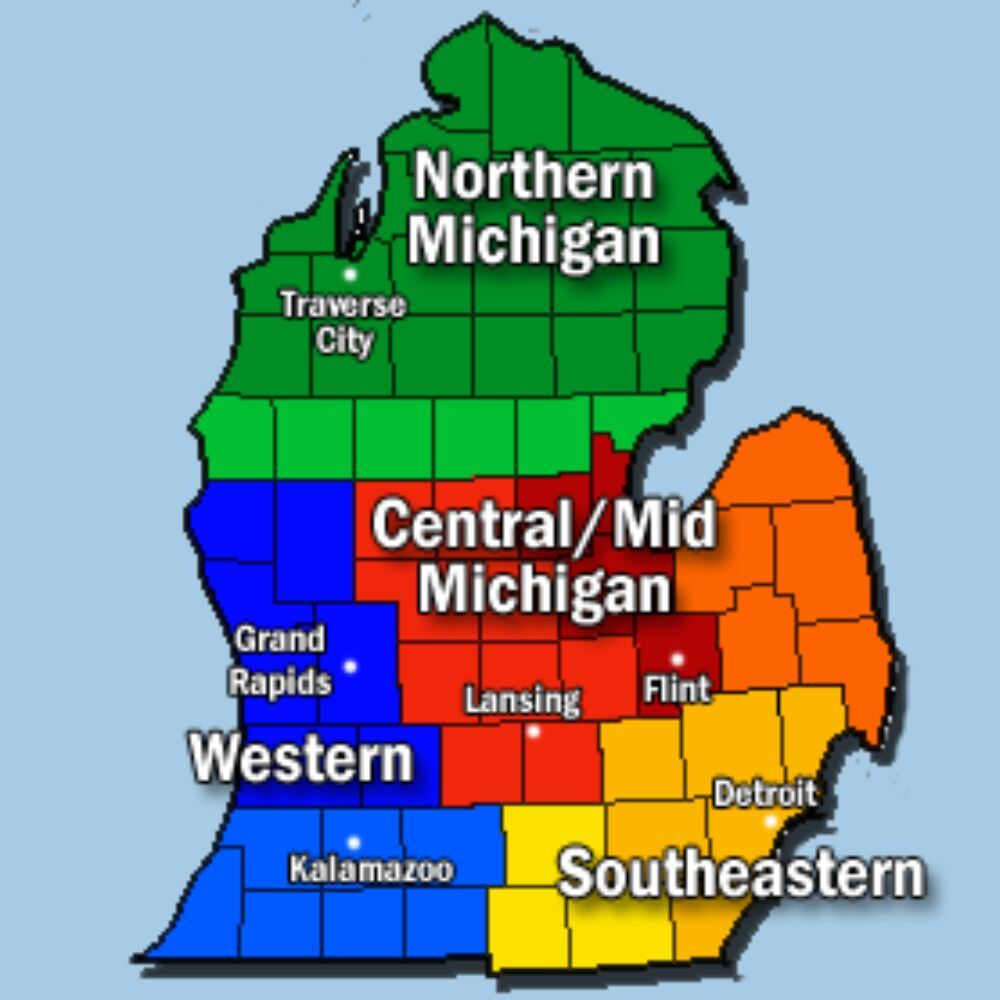Located in the middle east central states of the United States, Michigan is named after the French version of the Ojibwa word mishigamaa (ᒥᓯᑲᒥ), meaning "big water" or "great lake". The state consists of two separate peninsulas and has extensive shorelines on four of the five Great Lakes: Lakes Superior, Michigan, Huron, and Erie. Together, these interconnected lakes form the world's largest body of fresh water and border the eastern and central regions of North America.

Bordering the Canadian province of Ontario, Michigan shares land borders with Ohio, Indiana, and Wisconsin in the United States, and maritime borders with Illinois and Minnesota. Known as the Great Lakes State, the Wolverine State, and even the Mitten State, Michigan proudly asserts its geographic identity. Its capital, Detroit, has historical significance as the birthplace of the American automobile industry. Detroit is also a cultural center influencing modern music genres such as the Detroit sound, Motown, Detroit hip-hop, garage rock or proto-punk, and Detroit techno. Michigan, with its diverse landscapes and cultural contributions, stands as a unique and multifaceted state within the wider American landscape.
Read more California Map (CL): View geographic areas, population, cities and towns
Michigan state map
Advanced cartographic drawings provide an overview of the U.S. state of Michigan, identifying its boundaries, major geographic features, and key infrastructure components. This detailed map clearly shows the capital city of Lansing, which serves as the center of administrative activities.

The major cities are strategically identified, which allows understanding of urban topography and population distribution within the state. A complex network of rivers and lakes, including the vast Great Lakes (Superior, Michigan, Huron, and Erie), is spectacularly displayed, reflecting the state's rich aquatic landscape.
Click here to download a detailed PDF map of Michigan.
Michigan geographic region
Known for its unique topography, Michigan has an unusual shape as it occupies two different peninsulas. At 250,485 square kilometers (96,713 sq mi), Michigan is larger than England. It is worth noting that as the largest of the East Central states, Michigan is about seven times larger than Alaska.
Michigan, known as the Wolverine State, is divided into the Upper and Lower Peninsulas. The Historic Mackinac Bridge The peninsula was physically isolated until it was built in 1957. This engineering marvel facilitated seamless connectivity between the two regions, bridging the geographic gap and connecting the upper and lower peninsulas.
1. Upper Peninsula

Michigan's Upper Peninsula has a varied topography, with low hills and intermittent swamps in the east and rolling hills in the west. The eastern sector corresponds to the Great Lakes Plateau, which contributes to the creation of a relatively smooth landscape. In contrast, the western portion extending from Lake Superior to the Porcupine Mountains is located on the upper plateau and exhibits higher and more rugged topography. This unique landscape adds to the unique beauty and natural diversity of Michigan's Upper Peninsula.
2. Lower Peninsula

source | Wikipedia
The Lower Peninsula, a major part of the Great Lakes Plain, is bordered on the west by Lake Michigan, on the east by Lake Huron and Lake Erie, and on the south by Indiana and Ohio. The topography consists of a series of features featuring low hills in the southern part and plains interspersed with hills in the northern part. This diverse topography contributes to the geographic richness of Michigan's Lower Peninsula, which offers a variety of landscapes from gentle slopes to many rugged settlements.
The Lower Peninsula includes four major landforms.
- The southern part of the bay is covered by a mountainous moraine region, characterized by the presence of moraines, deposits of rocks and sediments transported and deposited by glaciers, which form low ridges on the landscape. These unique geological formations contribute to the mountainous terrain below the peninsula, a landscape shaped by the forces of changing glaciers and resulting sedimentation.
- In the lower peninsula, the coastal and dune areas feature a spectacular array of lowland forests interspersed with large sand dunes. This beautiful environment reflects the harmonious interaction between lush vegetation and large sand formations.
- Stretching north from the Muskegon-Saginaw Bay area is the plateau and moraine section, characterized by high mountains that make for a varied and rugged terrain.
- The Eastern Lower Plains, stretching from the Saginaw Bay area to the tip of the Lower Peninsula, is a large region that includes the most affluent parts of the state, including the most affluent city of Detroit. Known for its economic activity, this region provides a unique landscape that distinguishes Michigan's Lower Peninsula from other parts of the peninsula.
Also Read List of US States: Check how many states are in the US
Michigan cities and towns
Detroit is considered a major city because of its industry and shipping center on the Great Lakes:
Big and small cities | |||||
Detroit | Big rapids | Burrow | Stirling Highlands | lansing | Ann Arbor |
Flint | You are born dear | Livonia | Adrian | the soul | Alpena |
Battle river | Bahia City | Benton Harbor | Great rapids | Rig | Cadillac car |
Cheboygan | Claire | Cold water | Copper port | Crystal Falls | East Lansing |
Escanaba | Frankfurt | Mr. Gay | Happy stone | The great port | gray |
Hancock | Harrisville | Dutch | Houghton | Iron mountain | Iron tree |
It is spreading. | Jackson | Kalamazu | Kentwood | Anse | Ludington |
Mackinaw City | Monist | Monist | Marchetta | Manomine | Central |
Monroe | Good mountain | Munitions | moss gong | I'm not angry | Fresh berries |
The Nile | Norton Beach | Antonagon | Avosa | Petaski | Pontianak |
Port of Austin | Port Huron | Portage | City woods | Rogers City | saginaw |
Su Maria | San Ignacio | San Juan | Saint Joseph | It's the operator. | Tavas city |
Taylor | Three rivers | Cross town | Troy | Wyoming | |
Michigan State History
Between 1660 and the end of French rule, Michigan was an integral part of the royal territory of New France.
In the 17th century, the pioneers of exploration and settlement in the region were French-Canadian fur traders and Jesuit missionaries. In the year In 1691, the French built Fort St. Joseph as a strategic trading post near the St. Joseph River. Then in 1701 they established Fort Pontchartrain du Detroit (Fort Detroit), an important center for the fur trade and transport.

A major change came in 1760 when British troops occupied French Montreal, ending the French and Indian War (1754-1763). Thus, the region now known as Michigan gradually became part of the English province of Quebec. Until the change of the Erie Canal in 1825, the demographics of the Michigan Territory consisted primarily of Detroit and the surrounding area. Unprecedented population growth. In the year In 1830, Michigan had an impressive population of 80,000, which exceeded the threshold for statehood. On January 26, 1837, President Andrew Jackson signed a law officially granting Michigan statehood. Michigan later became the 26th member of the Union.
Read more about the largest states in the United States by population
Racial and ethnic groups
Nation | Percentage |
The target | 74.90% |
Afro-American | 14.10% |
Hispanic | 5.20% |
Asia | 3.40% |
Native Americans | 0.70% |
The people of Michigan
The tenth most populous state in the United States, Michigan had a population of approximately 10 million as of July 2023 . The state capital is Lansing and the most populous city is Detroit, Michigan's largest metropolitan city, Metro Detroit, which is the second largest metropolitan area in the entire United States.
In addition to Detroit, Michigan has other large cities with over 100,000 residents each. These urban centers include Grand Rapids, Warren, Sterling Heights, Ann Arbor, and Flint, which contribute to the state's diverse and dynamic demographics.
Read more


Post a Comment